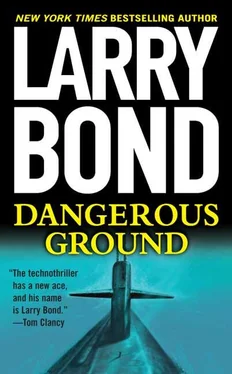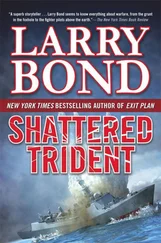“Aye, sir, I’ll do my best,” Jerry replied as he gave his XO an informal salute. Lifting his head to the bridge access trunk, Jerry yelled, “Up ladder,” and started climbing.
The bridge was prepared for sea with an assortment of electronic gadgets installed in the cockpit. The portable “bridge suitcase” with the communications gear and navigation instruments had been installed and tested. Since anything left on the bridge would be exposed to extreme water pressure when the boat submerged, the instruments used to conn Memphis were built into a removable case that could be quickly detached when the boat was ready to submerge. Next to the suitcase were an electronic chart plotter and a GPS receiver. A satchel bag lashed to the side contained paper charts, a flashlight, and a bullhorn. The Plexiglas windscreen had been secured in front of the cockpit, along with a grease pencil on a string. Behind Jerry was the “flying bridge,” an area atop the sail where an installed steel frame allowed additional people to stand safely while the ship made its surface transit.
Jerry checked the pier. The boat was divorced from shore power and the sanitary and potable water connections had also been removed. A small crane was working its way down the pier; it would be needed to lift the gangplank off the sub’s hull. Down on the deck, Jerry could see the line handlers mustering with the COB and Lenny Berg. Undoubtedly, the COB was reminding everyone about the proper safety precautions when handling the bulky mooring lines.
He looked at his pocket checklist to make sure he had gone over everything he would have to do to get the sub underway. He was thankful he had spent some extra time studying, even though he had fallen asleep the night before while reviewing Dutton’s Naval Shiphandling. But not all knowledge can be gained through an intensive book study effort. Theoretically, he knew what to do. Now it was time to put that theory into practice.
Noises from below told Jerry that others were coming up. Within a few seconds, a familiar voice spoke, “Permission to come up to the bridge.”
“Granted,” replied Jerry.
Petty Officer Stewart climbed into the cockpit with a pair of binoculars and a sound-powered phone headset. “Here you go, sir,” said Stewart as he handed the binoculars to Jerry. Jerry took them and thanked Stewart, who was busily putting on the sound-powered phones. Soon thereafter, Lieutenant Millunzi climbed up the ladder and joined Jerry in the cockpit. Millunzi had barely straightened up when he began bombarding Jerry with questions on the status of the bridge equipment and the topside area below. Jerry answered them quickly and concisely. Satisfied, Millunzi turned to Jerry and said, “Jerry, this is the one time that I will give you free advice. After this I charge a can of soda for every problem you want me to help you with.” The smirky grin on Millunzi’s face told Jerry that the MPA was quite serious.
“In that case, sir, what is your favorite liquid refreshment? Because I’m going to need a couple of six-packs to get me through our upcoming deployment.”
“Dr Pepper, of course. And you’d better make it three.”
Both men chuckled a bit and Jerry started feeling a little less tense. He didn’t realize just how anxious he was as he waited for things to get started.
“The secret of being a good shiphandler, Jerry, is to be able to manage inertia and momentum,” said Millunzi in a more sober tone. “You are used to driving a fighter that doesn’t weigh a lot but goes really fast. Memphis weighs several thousand tons and moves at a snail’s pace, by comparison.” He then pointed aft and asked, “What do you see back there, Jerry?”
Jerry faced aft and after a moment turned back toward the MPA, looking confused. “I don’t understand, sir.”
Millunzi pointed toward Memphis’ stern and said. “What do you see?”
Jerry looked again. “The rudder, sir?”
“Exactly!” shouted Millunzi happily. “Half of the rudder, your control surface, is out of the water flapping in the breeze, where it doesn’t do a damn thing for you. She’s great underwater, but on the surface and at slow speed, Memphis is a pig. She won’t respond quickly to rudder orders, so you have to think way ahead if you are going to effectively maneuver her. That’s the deceptive part of conning a sub on the surface: They move slow enough so that you think you have plenty of time to get out of trouble. In fact, if you don’t react in time, which means early, inertia will take over and ruin your entire day.”
“Mr. Millunzi, sir,” interrupted Stewart. “The XO reports that the maneuvering watch is set and that the Captain, the Commodore, and the pilot will be up shortly.”
“Very well,” responded Millunzi. Picking up the microphone and handing it to Jerry, he added, “Okay, Jerry, time to take the conn. You know what needs to be said. Just take a deep breath and let the maneuvering party know who is giving the rudder orders.”
Reaching for the mike, Jerry actually felt his hand shake a little. “Attention in the maneuvering party. This is Lieutenant (j.g.) Mitchell; I have the conn. Lieutenant Millunzi retains the deck.”
One by one, the various positions acknowledged the announcement.
“Helm aye.”
“Nav aye.”
“Radio aye.”
“Contact coordinator aye.”
“Maneuvering aye.”
“See? That wasn’t so hard. Ahh, here is our friendly tug to assist us,” said Millunzi.
Jerry looked up and saw a small red and black tug, with a great big yellow capital T on its black stack, maneuvering into position on Memphis’ port quarter. The handheld radio crackled to life and Millunzi exchanged a communications check and greetings with the master of the tug Paul A. Wronowski —or “Tug Paul” for short. Once Memphis was firmly secured to Tug Paul, Millunzi grabbed the bullhorn and shouted, “On deck, single up all lines!” The linehandlers quickly moved to reduce the number of lines between Memphis’ cleats and the pier’s bollards from two to one.
Millunzi was getting ready to say something when Hardy, climbing up the ladder, interrupted him. “Captain to the bridge.”
Both junior officers crammed themselves to one side to make room for Hardy, the commodore, and the pilot to come up from the bridge access trunk. After the three of them were situated on the flying bridge, Hardy asked, “Mr. Millunzi, are we ready?”
“Just finishing the final arrangements topside, sir.” He nodded to Jerry. “I was instructing Mr. Mitchell on some of the trickier parts of conning a submarine on the surface.”
“Hmpf,” replied Hardy, turning to face Jerry. “Mr. Mitchell, I agreed with the XO’s recommendation that we make you the conning officer for the maneuvering watch, in spite of the fact that you have only been a member of my crew for a short period of time. This is a required assignment for all junior officers and you need the experience. I wish your first time underway was under different circumstances, but there are no easy underways on my boat.”
Jerry could only nod. “Yes, sir, I’ll do my best.”
“What’s the hand signal for a tug to make half speed?”
“Point with your index finger in the direction you want the tug to push, either ahead or astern.”
It was the correct answer, but Hardy only frowned. “Will you be using hand signals today?”
“No, sir. With Tug Paul’s bridge facing aft, it would be better to use the handheld radio to reduce the chance of a misunderstanding.”
Again, Jerry gave the correct answer. Hardy looked unimpressed. “Very well, make your report.”
Jerry looked at Millunzi, who nodded slightly, and then began the long and detailed report on the status of Memphis’ preparation for getting underway. This formal, almost ritualistic, approach ensured that the Captain and the Officer of the Deck were both working with the same information. And while a good CO probably already knew everything his OOD was reporting, double checks were never wasted.
Читать дальше












